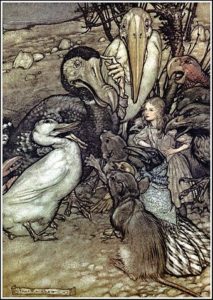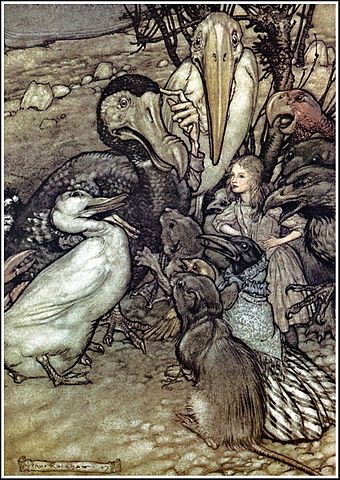
In order to get dry after a swim, the Dodo in Alice in Wonderland proposed that everyone run a race. He said the participants could run anyway they want. They could even start and stop whenever they wanted. When the race was completed and the Dodo bird was asked who won, and he said: “Everybody has won, and all must have prizes.” Intriguingly, the Dodo’s announcement has been used as a metaphor when discussing the outcome research of psychotherapeutic approaches.
The metaphoric application of the dodo bird effect to describe the equivalence of effectiveness when comparing psychotherapies first occurred in a classic paper written by Saul Rosenzweig in 1936: “Some Implicit Common Factors in Diverse Methods of Psychotherapy.” The article was republished in the July 2010 issue of the American Journal of Orthopsychiatry, which you can read if you pay APA PsycNET $11.95. An alternative approach would be to read an article by Barry Duncan, “The Legacy of Saul Rosenzweig: The Profundity of the Dodo Bird” available for free under the link.
Duncan saw Rosenweig’s article as having a clairvoyant ability to predict the intervening years of research that underlies the argument for the common factors perspective of psychotherapeutic approaches. Essentially Rosenweig (and the common factors approach) attributed the positive outcomes of these approaches to factors common to the various therapies and not necessarily to the particular therapeutic approach itself. Michael Lambert made a significant contribution to the modern sense of the common factors perspective, according to Duncan, when he identified four therapeutic factors as the principle elements accounting for improvement in psychotherapy. Based upon Lambert’s work, Scott Miller and a team of researchers expanded the use of the term “common factors” from its traditional sense of nonspecific relational factors to include four specific factors: client, relationship, expectancy and placebo, and technique.
Clients have been typically portrayed as passive targets or recipients for the all-important technical intervention of a therapy. However, research by Tallman and Bohart demonstrated “that the client is actually the single, most potent contributor to outcome in psychotherapy—the resources clients bring into the therapy room and what influences their lives outside it.” Client attributes like persistence, openness, faith, optimism, supportive family members, or membership in a religious community might be important factors operative in the individual’s life before they enter therapy. “Assay and Lambert ascribed 40% of improvement during psychotherapy to client factors.” This is a departure from the conventional emphasis on the contribution of the therapist, the therapeutic model or technique.
Clients are the main characters, the heroes and heroines of therapeutic stage, and they are the most potent contributor to psychotherapeutic change. This common factor suggests that therapists eschew the five Ds of client desecration (diagnosis, deficits, disorders, diseases, and dysfunction) and instead find ways to enlist the client in service of client goals. Whatever path the psychotherapist takes, it is important to remember that the purpose is to identify not what clients need but what they already have that can be put to use in reaching their goals.
Regardless of the therapist’s theoretical approach, relationship variables account for 30% of successful outcome variance in therapy. “Next to what the client brings to therapy, the therapeutic relationship is responsible for most of the gains resulting from therapy.” Related to this, the client’s perception of the relationship is the most consistent predictor of therapeutic improvement.
The core conditions identified by Carl Rogers as “necessary and sufficient” conditions for personal change in therapy are accepted as important factors by most schools of therapy. These core conditions, accurate empathy, positive regard, nonpossessive warmth and genuineness, have been empirically supported. They are also consistently reported in client reports of successful therapy.
“Placebo, hope and expectancy” is estimated to contribute 15% to the outcome of psychotherapy. In part, the client’s assessment of the credibility of the healing rituals of the therapy’s rationale and related techniques play a role here. These curative effects come from the positive and hopeful expectations that accompany the use and the implementation of the therapeutic method. “Rituals are a shared characteristic of healing procedures in most cultures.” The procedures are not the causal agents of change. “What does matter is that the participants have a structure, concrete method for mobilizing the placebo factors. From this perspective, any technique from any model may be viewed as a healing ritual.”
In Persuasion and Healing, Jerome Frank said the therapeutic enterprise has a strong expectation that the client will be helped. He suggested that an underlying factor to all the different approaches to psychotherapy, like the placebo in medicine, is that people are offered hope that something can be done to help them. Sometime merely the name of a therapeutic procedure mobilizes a person’s hope of relief. “For therapy to be effective, patients must link hope for improvement to specific processes of therapy as well as to outcome.” Frank said:
Despite differences in specific content, all therapeutic myths and rituals have functions in common. They combat demoralization by strengthening the therapeutic relationship, inspiring expectations of help, providing new learning experiences, arousing the patient emotionally, enhancing a sense mastery or self-efficacy, and affording opportunities for rehearsal and practice.
Therapeutic models and techniques account for 15% of improvement in therapy. Conceived broadly, model/technique factors can be understood as therapeutic or healing rituals. From this perspective, even therapies like EMDR, eye-movement desensitization response, offer nothing new. When a therapist tells a client “to lie on a couch, talk to an empty chair, or chart negative self-talk,” they are engaging in healing rituals.
Because comparisons of therapy techniques have found little differential efficacy, they may all be understood as healing rituals—technically inert, but nonetheless powerful, organized methods for enhancing the effects of placebo factors.
Rosenzweig said it mattered little whether the therapist talked in terms of psychoanalysis or Christian Science. What counted was “the formal consistency with which the doctrine used is adhered to, thereby offering a systematic basis for change and an alternative formulation to the client.”
And yet, the therapy field continues to be “model maniacal,” according to Duncan. He quoted Arthur Bohart as saying the dodo bird effect is ignored because it is so threatening to special theories. “The data call for a change in how we view therapy, but the field continues to stick to the old technique-focused paradigm.” Another reason is the ongoing search for the GUT—the Grand Unified Theory—of therapy that cures all or most suffering individuals. But the cure always seems just around the corner or just out of reach.
Self-proclaimed experts present mysterious scans of brains showing incontrovertible truth that “mental illness” exists and medical science is on the verge of conquering it. But when reality sets in, therapists know that they can never produce the epic transformations witnessed on videos or reported in edited transcripts. Psychotherapists painfully recognize that colorized brain images will not help when they are alone in their offices facing the pain of people in dire circumstances.
The final reason the dodo bird effect is ignored is because clinicians are too invested in the privilege model perpetuated by graduate schools, professional organizations and managed care companies. Psychiatrists are one example, particularly with their hegemony of targeting particular drugs as treatments for specific disorders. Drawing from the medical example of evidence-based practice, there are a growing number of evidence-based or evidence-verified treatments. But the EVT position essentially ignores the 40 years of outcome data about common factors and the truth of the dodo bird effect.
The dodo bird effect means that the client and what they bring to the therapeutic encounter is the most important factor for its effectiveness, rather than the therapist or the therapy. The next most important factor is the therapeutic relationship of client and clinician. Consequently, relationship skills such as acceptance, warmth and empathy are fundamental for establishing a good therapist-client relationship. A therapist with these skills will ensure their practice doesn’t go the way of the dodo bird, which went extinct in the 1600s.





